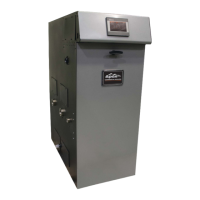94
106308-05 - 3/23
APEX Installation, Operating, & Service Instructions
8. Central Heat Parameters
Select to access the following parameters.
Parameter and Description Factory Setting Range / Choices
Central Heat Setpoint
Target temperature for the central heat priority. Value also used by the outdoor air
reset function.
180°F
(82.2°C)
50 to 190°F
(10 to 87.8°C)
Time of Day Setpoint
Used when an EnviraCOM thermostat is connected to the boiler and is in Sleep or
Away mode. When setback is “on” the time of day setback setpoint shifts the reset
curve to save energy while building is in a reduced room temperature mode. The
reset curve is shifted by the difference between the High Boiler Water Temperature
and the TOD Setback Setpoint.
170°F
(76.7°C)
50 to 190°F
(10 to 87.8°C)
Difference Above
The boiler stops when the water temperature rises ‘Difference Above’ degrees above
the setpoint.
10°F
(-12.2°C)
2 to 25°F
(-16.7 to -3.9°C)
Difference Below
The boiler starts when the water temperature drops ‘Difference Below’ degrees
below the setpoint.
5°F
(-15°C)
2 to 25°F
(-16.7 to -3.9°C)
Response Speed
This parameter adjusts the Central Heat temperature controller Proportion Integral
Derivative (PID) values. Higher values cause a larger firing rate change for each
degree of temperature change. If set too high firing rate “overshoots” required value,
increases to high fire causing the temperature to exceed the “Difference Above”
setpoint and cycle the boiler unnecessarily. Lower values cause a smaller firing
rate change for each degree of temperature change. If set too low, the firing rate
response will be sluggish and temperature will wander away from setpoint. Refer to
Table 10-20 for PID values used by these selections.
3 1 to 5
Central Heat Low Fire Hold Time
“Low Fire Hold Time” is the time the control will wait at low fire modulation rate before
being released to modulate. After ignition and flame stabilization periods, firing rate
is held at low fire for “Low Fire Hold Time”. This delay allows heat to travel out to the
system and provide system feedback prior to the control modulating firing rate.
120 seconds 0 to 1,800 seconds
CH Modulation Sensor
Determines which temperature sensor the boiler responds to with Central Heat
demand. Outlet Sensor is the boiler’s internal supply sensor. When Header Sensor
is selected the boiler is fired in response to the sensor wired to Header Sensor
terminals. NOTE: When Header Sensor is selected, also set Boiler Pump parameter
to Header Sensor / Combustion Air Damper.
Outlet Sensor
Outlet Sensor
Header Sensor
10 Operation (continued)

